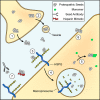Prion-like properties of Tau protein: the importance of extracellular Tau as a therapeutic target
- PMID: 24860099
- PMCID: PMC4106306
- DOI: 10.1074/jbc.R114.549295
Prion-like properties of Tau protein: the importance of extracellular Tau as a therapeutic target
Abstract
Work over the past 4 years indicates that multiple proteins associated with neurodegenerative diseases, especially Tau and α-synuclein, can propagate aggregates between cells in a prion-like manner. This means that once an aggregate is formed it can escape the cell of origin, contact a connected cell, enter the cell, and induce further aggregation via templated conformational change. The prion model predicts a key role for extracellular protein aggregates in mediating progression of disease. This suggests new therapeutic approaches based on blocking neuronal uptake of protein aggregates and promoting their clearance. This will likely include therapeutic antibodies or small molecules, both of which can be developed and optimized in vitro prior to preclinical studies.
Keywords: Aggregate Propagation; Alpha-Synuclein (a-Synuclein); Chemoprevention; Neurodegenerative Disease; Prion; Tau Protein (Tau); Therapy.
© 2014 by The American Society for Biochemistry and Molecular Biology, Inc.
Figures

References
-
- Thies W., Bleiler L. (2013) 2013 Alzheimer's disease facts and figures. Alzheimers Dement. 9, 208–245 - PubMed
-
- Braak H., Braak E. (1991) Neuropathological stageing of Alzheimer-related changes. Acta Neuropathol. 82, 239–259 - PubMed
-
- Ravits J., Paul P., Jorg C. (2007) Focality of upper and lower motor neuron degeneration at the clinical onset of ALS. Neurology 68, 1571–1575 - PubMed
-
- Prusiner S. B. (1993) Genetic and infectious prion diseases. Arch. Neurol. 50, 1129–1153 - PubMed
Publication types
MeSH terms
Substances
Grants and funding
LinkOut - more resources
Full Text Sources
Other Literature Sources
Miscellaneous

